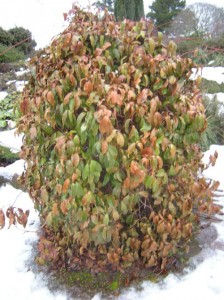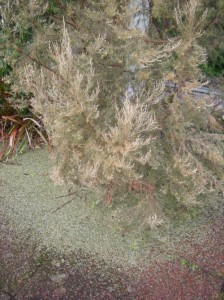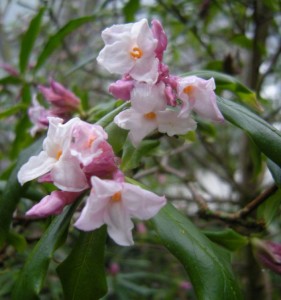Continual snow cover since 18th December until 15th January; cold desiccating winds and low temperatures. The 100mm soil minimum reached -13.7oc on 24th December. The air temperature recorded below zero from 1st December 2009 until 10th January, with the exception of Tuesday 15th December when we recorded +0.1oc. These factors combined to make life very difficult for evergreens. With frozen soil around the roots these plants could not take up soil moisture to replace that lost through transpiration. The evapotranspiration rate during periods of cold winds is high and the following plants illustrate damage that has occurred at the Garden this winter.
Two plants with thicker leathery leaves that did not appreciate the cold were the Kadsura japonica at the bridge in the rock garden and the well established Gordonia in the M beds. Both have severe discolouration to the leaves.
Nearby are patches of Bergenia which have “gone flat” with the cold. The normally messy clumps of evergreen leaves almost looked tidy as they reduced their surface area and flopped.
The tightly rolled leaf bud spires of Lysichiton americanus show burnt tops; these will rapidly grow out of this damage as only the outer sheath bears the brunt of the cold damage.
Surprisingly the two metre tall woody Phygelius ‘African Queen’ has remained green to the tip of its fresh soft shoots. Nearby, last seasons growth on Penstemon c.v. is browned.
In the south facing borders at the front range Callistemon citrinus ‘Splendens’ has desiccated growth, yet still gives off it’s citric odour. Erica caffra from the Cape resembles a Christmas tree on twelfth night having dropped 50% of its needles due to the cold. The east facing border with the Crinum collection is a mass of mush, the leaves having turned prematurely to compost.
Plants are resilient, don’t be tempted to grub out or prune cold damaged vegetation until rising temperatures and a more benign climate returns as spring arrives. A mention of spring must include the scented pink blooms of Daphne bholua standing sentinel in the corner of the sunken courtyard to the north of the Front Range. Always a positive sign of better things to come.



